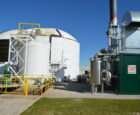Last month, MSU’s George Smith (director of the university’s AgBioResearch division) and Wei Liao, director of MSU’s Anaerobic Digestion Research and Education Center, testified before the Michigan House Agriculture Committee, vouching for the critical role that anaerobic digesters can play in the protection of the Great Lakes ecosystem.
Anaerobic digestion is a natural biological process in which microorganisms break down organic materials, including livestock manure (and also, commonly, food waste) in a no-oxygen environment, resulting in both biogas and digestate. The biogas can be used to generate electricity and thermal energy or can be refined into RNG, while digestate can serve as a nutrient-rich amendment.
MSU has operated its own full-scale digestion facility for more than 12 years, processing approximately 15,000 gallons of animal and food wastes, including dairy and swine manure, and other food and processing wastes. The facility generates 6,500 kilowatt-hours per day of renewable electricity and produces 15,000 gallons of digestate daily. That digestate has been land-applied across the university’s farmland under Michigan’s Generally Accepted Agricultural and Management Practices, guided by soil test data and monitored regularly. According to MSU, this monitoring has shown no evidence of groundwater contamination.
Recognizing growing public concern about the potential for emerging contaminants — including heavy metals, per- and polyfluoroalkyl substances (PFAS), pharmaceuticals, and microplastics — to be present in organic waste streams, MSU researchers have taken a proactive role in investigating and managing these risks. Targeted measurements have been conducted on digestate samples to assess the presence of trace elements and regulated substances, with ongoing studies evaluating the fate and transport of contaminants during the digestion process and after land application.
Liao, a professor in the MSU Department of Biosystems and Agricultural Engineering, said while concentrations of these substances are often low or below detection limits, MSU’s approach emphasizes science-based application practices, comprehensive waste source assessment and alignment with state and federal safety standards.
“The on-going efforts reflect MSU’s commitment to ensuring that anaerobic digestion remains not only a renewable energy and nutrient recovery strategy, but also a safe, responsible and resilient system for protecting public health and natural resources in the Great Lakes region,” Liao said.
The economic potential of anaerobic digestion in Michigan is vast, Liao said. “This integrated waste-to-resource approach holds promise in an agriculturally abundant and diverse state such as Michigan, where water quality concerns — especially in the Great Lakes basin — also demand urgent attention,” Liao said.
Beyond energy, MSU’s digestion programs and technologies are focused on maximizing nutrient and water recovery from organic waste streams, as researchers actively address growing concerns about emerging contaminants in digestate, such as PFAS, heavy metals, pharmaceuticals and microplastics, while also devising best management practices to minimize risks.
“By stabilizing and concentrating nutrients in forms that match crop needs, and reclaiming water for agricultural or industrial reuse, anaerobic digestion systems offer a closed-loop strategy to enhance soil health, reduce chemical fertilizer dependence, mitigate the spread of emerging contaminants and protect Michigan’s freshwater resources — including the Great Lakes, which supply drinking water to over 40 million people,” Liao said.
“Anaerobic digestion is a tool for simultaneously cutting greenhouse gas emissions, recovering nutrients and water, and revitalizing rural economies. We at ADREC welcome policymakers, industry leaders, philanthropists and the general public to join us in supporting this transformative work.”















